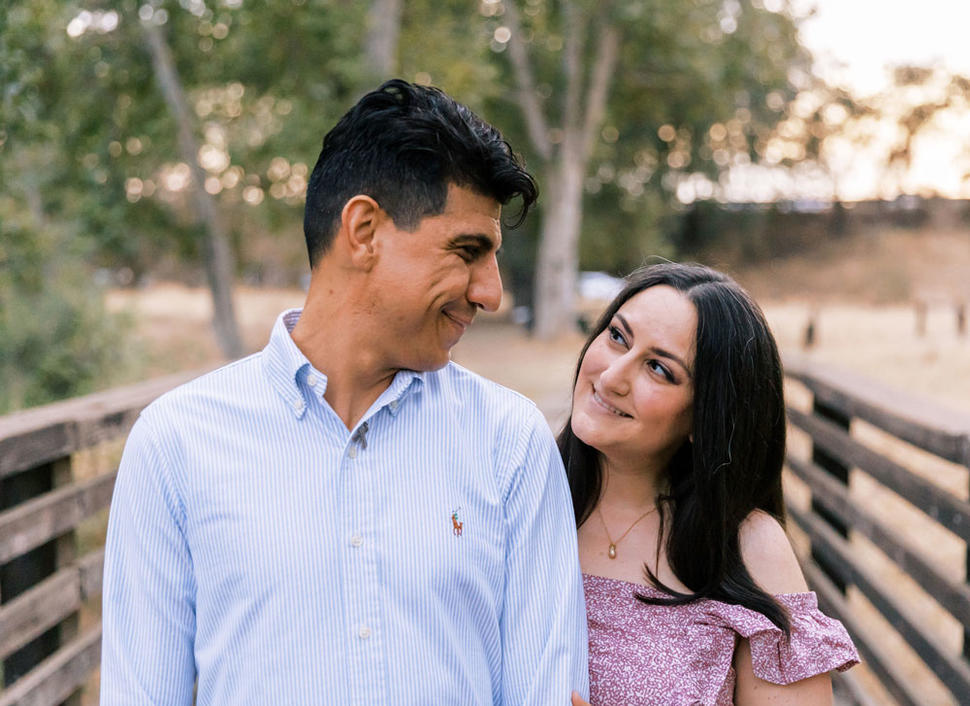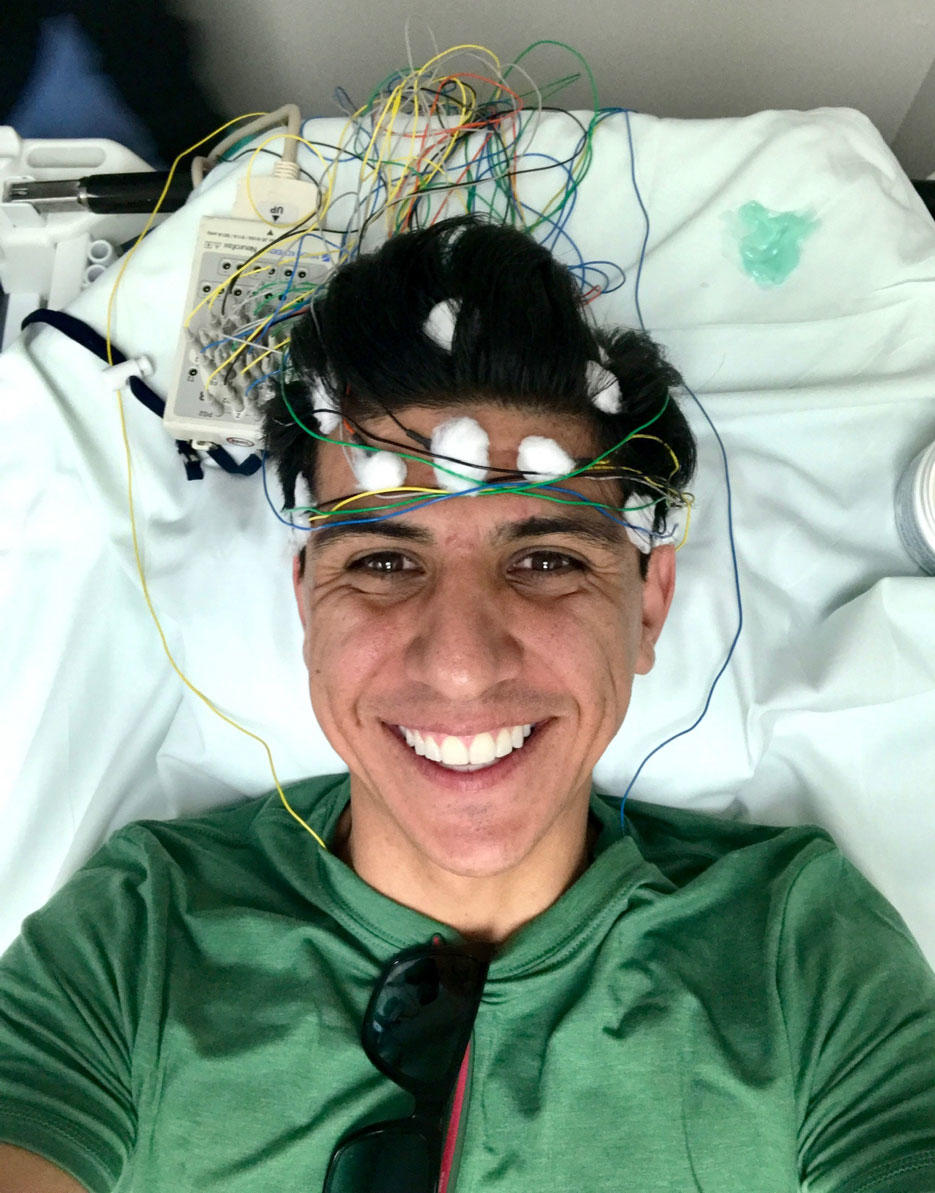Navigating a Rare Brain Tumor Diagnosis: A Care Partner’s Perspective
, by Liz, Ependymoma Care Partner
Liz never imagined that she would become a care partner to her vibrant husband Julio because of an ependymoma diagnosis. She shares their journey and how they work together as a team through the good times and the bad.
In 2007, Julio was in the Navy and stationed in Central California. One day, he showed up in my living room with some mutual friends. After his first deployment in 2008, we became close friends and our friendship later shifted to dating. We’ve been married for 10 years now, and our friendship has grown even stronger as we’ve faced the challenges of Julio’s brain tumor diagnosis together.
Julio’s next duty station was in Europe, where we spent several years. After returning home to the United States, he started having episodes during which he couldn’t speak. They lasted about 30 seconds and were infrequent at first. Once the frequency increased, he informed his doctor who suggested the issue might be anxiety or too much caffeine. He was referred to a psychologist who immediately sent him to a neurologist.
On August 29, 2018, Julio had an awake craniotomy at the University of California, San Francisco (UCSF), several hours from our home. His pathology showed that he had an anaplastic ependymoma, a rare central nervous system tumor. After surgery, he completed six weeks of radiation and had clear scans for about two years.
In 2019, Julio visited the NCI-CONNECT Clinic at NIH in Bethesda, Maryland and enrolled in the Natural History Study. We met Marta Penas-Prado, M.D., senior clinician, and Terri Armstrong, Ph.D., the study’s principal investigator and deputy chief of the NCI Center for Cancer Research’s Neuro-Oncology Branch (NOB), during our first trip.
In September of 2020, Julio had a recurrence with scattered growth along the left side of his brain and dura. We’d always thought that if the tumor came back, we’d know how to handle it. But this experience was completely different than the first.
Julio’s primary neuro-oncologist at UCSF directed us to Dr. Penas-Prado to discuss clinical trials. We joined a clinical trial studying the drug marizomib, which targeted not only ependymoma but also RELA-fusion, a genetic alteration shown in Julio’s 2018 pathology.
Unfortunately, he had to withdraw from the trial after one month due to massive growth we discovered while in Tulsa, Oklahoma on a road trip. We flew back to California for emergency debulking surgery and began working with an integrative oncologist. We focused on nutrition, supplements, and whole-body health (including acupuncture, exercise, and mental health).
Searching Beyond the Standard of Care
There aren’t many “standard of care” options with a rare tumor. Numerous treatments have ultimately failed to control Julio’s tumors, and each failure is a gut punch. He’s tried radiation, oral chemotherapies, infusion chemotherapy, Gamma Knife radiosurgery, and immunotherapy—including a phase 2 trial for people with rare brain and spine tumors led by Dr. Penas-Prado.
In September 2022, we were seemingly out of viable options and learned Julio might only have three to six months left. His oncologist suggested a consult with a proton cancer therapy center in San Diego. Proton therapy was a long shot, but his oncologist didn’t want to leave any stone unturned. We waited two months for insurance approval while Julio’s health declined.
The day of our proton consult in November 2022, he stopped speaking and started losing strength in his right limbs. We fully expected to hear that he couldn’t be helped, but surprisingly we were offered two weeks of targeted proton therapy to his largest, fastest-growing tumor area. It saved his life.
In March 2023, Julio began infusions of a monoclonal antibody to control his brain swelling, which have been a game changer. He’s speaking and getting around much better and is working hard in both physical and speech therapies to regain some of what he’s lost. The proton-treated tumor area is currently stable, but there’s still growth in several other spots.
Once again, we are searching for viable treatment options. He just started using a wearable medical device that will hopefully give us a little more time to wait for another promising treatment. In May 2023, we attended Head to the Hill with the National Brain Tumor Society, as well as the Collaborative Ependymoma Research Network Foundation butterfly release. During the butterfly release, NOB Chief Mark Gilbert, M.D., spoke about NCI’s investment in improving patient outcomes, which gives us hope.
Rolling with the Punches
I never imagined I’d be a care partner for my vibrant husband because of a rare brain tumor. This path isn’t easy, and we frequently find ourselves torn between two bad options. We’ve dealt with medication side effects, “scanxiety,” physical and cognitive deficits, financial strain, challenges with jobs, and fertility issues. We’ve canceled numerous plans—and seizures sometimes like to tag along while we are doing Pilates, shopping, or snorkeling in the Caribbean.
My love for my husband motivates me to get through each day, each treatment pivot, each trip to the emergency room. I find myself helping him and giving him space in an ebb and flow; that’s how this Liz and Julio team works best. Some days he needs extra help, while other days he can do more on his own. I try to respect his independence and manage the things he finds overwhelming.
My love for my husband motivates me to get through each day, each treatment pivot, each trip to the emergency room. I find myself helping him and giving him space in an ebb and flow; that’s how this Liz and Julio team works best.
Brain cancer has caused the most terrifying moments in our lives, but surprisingly some of the most uplifting experiences as well. We have a completely different perspective on life and priorities than before Julio’s diagnosis, and our support system inspires us to keep forging our own path.
We’ve leaned into the brain tumor community through support groups, events, and advocacy. We designed special stickers as a fun way to raise awareness using the hashtag #JuliosBrain on social media. We’ve learned that self-advocacy in health care is crucial, as is finding a medical team you trust.
We’re lucky enough to have three collaborative neuro-oncology teams we love and trust. We try not to focus too much on the negative bits and instead invest in the positive parts of life, taking advantage of whatever time we have. We don’t know what the future holds, but we know that we have this moment, so we better enjoy it.
I asked Julio for words of wisdom, and he shared this: “Keep fighting. You’ll have good days and bad days and everything in between. You never know how strong you are until you have no choice but to be strong. Keep hope alive. Spread peace, love, and happiness. Be open. Listen to your body and talk to your medical team. Express your feelings and embrace the ones you love. Life is not fair, but if you roll with the punches, it helps soften the blow. Once someone told me that Liz is my lottery ticket, and I agree. I love my wife.”

